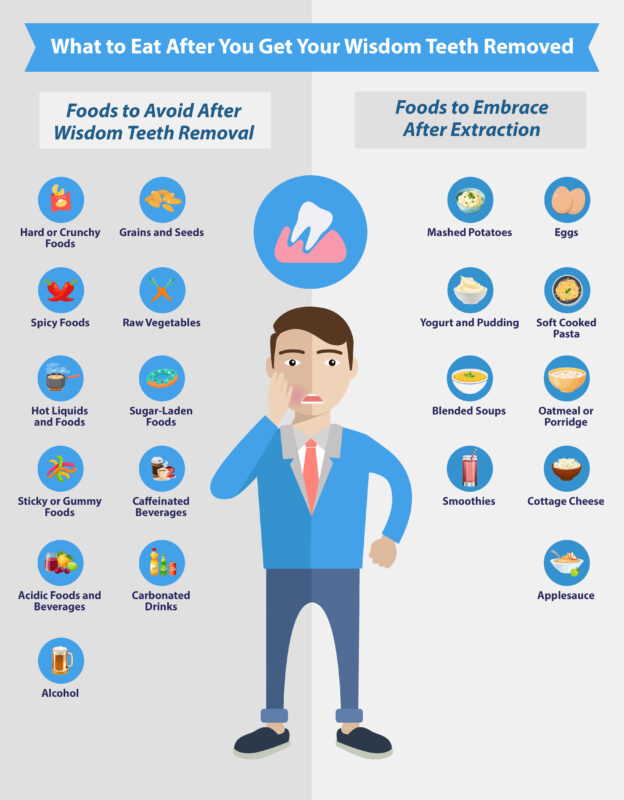Having your wisdom teeth removed is almost a rite of passage. While it’s a common procedure, especially for teens and young adults, it does require specific post-operative care for optimal recovery. One area that often gets overlooked is nutrition. What you eat (or avoid eating) after your wisdom teeth removal can significantly influence your healing process.
Why Proper Nutrition Matters After Wisdom Teeth Removal
You’ve likely heard the saying, “You are what you eat,” but never has this been more true than after oral surgery like wisdom teeth removal. The link between nutrition and post-operative care is undeniable; what you consume can significantly affect your recovery. Eating the wrong foods might not only lead to discomfort but can also cause complications that no one wants to deal with post-surgery.
A balanced diet rich in essential nutrients and vitamins can work wonders for your body as it heals. Protein, for example, plays a critical role in tissue repair. Vitamin C and other antioxidants aid in wound healing, reducing inflammation and the risk of infection. When you eat right, you’re essentially providing your body with the tools it needs to mend itself efficiently.
It’s not just about speeding up the healing process; it’s also about comfort and ease during recovery. Many of the recommended foods post-surgery are soft and easy to eat, which means they won’t aggravate wisdom tooth pain or disturb stitches. By avoiding foods that are hard, sticky, or sharp, you can dodge unnecessary pain and potential complications, allowing for a smoother, more comfortable recovery process.
To navigate this crucial period successfully, it’s essential to know the do’s and don’ts of post-operative nutrition.

Foods to Avoid After Wisdom Teeth Removal
Steering clear of certain foods after your wisdom teeth are removed can be just as important as knowing what to eat. Some foods can irritate the surgical area, potentially leading to complications like infections, delayed healing, and increased discomfort.
Here are some foods you should avoid during your recovery period:
Hard or Crunchy Foods: Items like chips, nuts, and hard candies can exert pressure on the healing surgical site and might even dislodge the stitches.
Spicy Foods: Hot sauces, wasabi, or dishes with a lot of chii can irritate the sensitive areas in your mouth, leading to unnecessary extraction site pain.
Hot Liquids and Foods: Steaming hot beverages and soups can exacerbate inflammation and may disturb the clotting process essential for healing.
Sticky or Gummy Foods: Chewing on taffy, gum, or anything that is sticky can pull on your stitches and even become lodged in the surgical site.
Acidic Foods and Beverages: Citrus fruits, tomato-based dishes, and sodas can irritate the healing gum tissue and should be consumed cautiously.
Alcohol: Not only can it dry out your mouth, which is bad for healing, but alcohol can also interact negatively with any post-operative medications you might be taking.
Grains and Seeds: Tiny food particles like seeds from strawberries or sesame seeds on a bagel can get stuck in the healing area, posing a risk for infection.
Raw Vegetables: While generally healthy, the act of crunching on raw veggies can be harmful to the surgical area.
Sugar-Laden Foods: Excess sugar can promote bacterial growth, which is something you want to avoid when your mouth is healing.
Caffeinated Beverages: Such as coffee and black tea, which can dehydrate you.
Carbonated Drinks: The bubbles can irritate the surgical sites.
Taking note of these food items and steering clear of them can significantly benefit your post-operative experience.
Foods to Embrace After Extraction
Switching to a diet of soft foods can be the most comfortable and beneficial choice after wisdom teeth extraction. These foods minimise the chance of irritation and are easy to chew, aiding in a smoother and faster recovery.
Here’s a list of soft foods you should consider incorporating into your post-operative diet:
Mashed Potatoes: Creamy and comforting, mashed potatoes are a go-to choice. Just make sure they aren’t too hot.
Yogurt and Pudding: Opt for varieties that don’t have granola or any added crunchy bits. They provide valuable nutrients without requiring much chewing.
Blended Soups: Think tomato, pumpkin, or carrot soups. They offer nourishment and hydration, but make sure they’re served warm, not hot.
Smoothies: Fruits are loaded with vitamins, and a fruit smoothie can be an excellent way to get your daily nutrients. Just avoid adding any seeds or hard fruits.
Eggs: Scrambled or boiled, eggs are a soft food that is high in protein, helping with tissue repair.
Soft Cooked Pasta: Overcooked noodles or macaroni and cheese are easy on your mouth and filling as well.
Oatmeal or Porridge: Prepare it a bit on the watery side to ensure it’s easy to eat.
Rice Pudding: A soft and tasty option that can be served either warm or cold.
Cottage Cheese: This dairy product is full of protein and doesn’t require any chewing.
Applesauce: The pectin in apples can aid in digestion, and the soft texture is perfect for a healing mouth.
Tips for Preparation and Serving:
- Always let hot foods cool down to a lukewarm temperature before eating.
- Use a blender or food processor to puree foods that aren’t naturally soft.
- Remember to sip water or herbal teas throughout the day for hydration and to help cleanse the mouth. Proper hydration aids in the healing process, keeps tissues moist, and can even help manage swelling and pain. Plus, a well-hydrated body can better fight off infections, a concern you don’t want to underestimate after getting your wisdom teeth removed.
By sticking to these soft food options, you not only provide your body with the necessary nutrients for speedy healing but you also alleviate potential issues and complications.
Timeline for Reintroducing Regular Foods
After your wisdom teeth removal, you might find yourself yearning for your usual food favourites. It’s crucial, however, to reintroduce regular foods into your diet with caution to avoid complications. Here’s a general timeline to guide you, although your dentist will be able to give you personalised advice.
Day 1-3 Post-Extraction: Stick to a liquid and soft food diet. It’s not the time to experiment with anything hard, spicy, or crunchy.
Day 4-7 Post-Extraction: You can begin to incorporate semi-soft foods like scrambled eggs, mashed potatoes, and soft pasta. Always start with small bites and chew gently.
Day 8-14 Post-Extraction: Gradually introduce foods with a bit more texture, like soft bread and cooked vegetables. Keep in mind that some slight discomfort is normal, but persistent pain should be addressed immediately.
After Two Weeks: At this point, you might feel ready to return to your regular diet. However, always consult with your dentist before making this transition. Taking it slow is key to a smooth recovery.
At Dentistry on Coolum, we’re always ready to assist you should you encounter any postoperative complications or have concerns about your recovery. For information on ways to relieve wisdom teeth pain or to recognise signs your wisdom teeth are coming in, feel free to consult our other resources.
Wisdom Teeth Removal at Dentistry on Coolum
Managing your diet post-wisdom teeth removal is more than just an exercise in culinary creativity. It’s a critical component of your overall recovery. Proper nutrition not only prevents complications but also speeds up the healing process, letting you get back to your regular routine much faster.
Dentistry on Coolum is dedicated to making your dental experiences as comfortable and hassle-free as possible, guiding you every step of the way. From the initial consultation to post-operative care and beyond, we’re here to ensure your oral health is in prime condition.Ready to take control of your oral health? Don’t wait to experience complications. Schedule your consultation or follow-up appointment at Dentistry on Coolum today.


